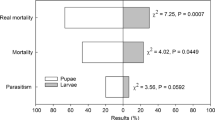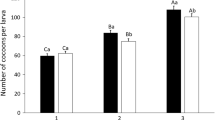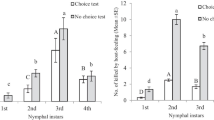The large white butterfly (Pieris brassicae L) first invaded northernmost Japan from Siberia around 1994, and after a few years, began to expand its range. The wasp, Cotesia glomerata (L) parasitizes larvae of the small white butterfly (Pieris rapae crucivora Boisduval), a usual host in the same geographic area. Some Pieris brassicae larvae in Hokkaido have been parasitized by Cotesia glomerata, but the parasitism rate of Pieris brassicae larvae tends to be lower than that of Pieris rapae. To examine the process of parasitizing Pieris brassicae larvae, we observed how the parasitoid wasp responded to the host larvae on damaged leaves. Cotesia glomerata females tended to avoid Pieris brassicae larvae, and even when female wasps inserted their ovipositors into Pieris brassicae larvae, none laid eggs. The parasitoids obtained from Pieris rapae larvae failed to parasitize Pieris brassicae during the host-acceptance step.
Similar content being viewed by others
References
Driesche R. G. V. & Bellows jr T. S. (1996) Biological Control. Chapman & Hall, New York.
Elton C. S. (1958) The Ecology of Invasions by Animal and Plants. Methuen, London.
Fujii H. (1997) Pieris brassicae, and its related species. Yadoriga 169, 2–6. (In Japanese.).
Fujii H. & Watanabe Y. (1997) Where is Pieris brassicae? Yadoriga 169, 10–24. (In Japanese.).
Hasegawa H. (1958) Small cabbage butterfly. Shin Konchu 11: 39. (In Japanese.).
Hiura I. (1973) Butterflies crosing over the sea. Soujyu Shobou. Tokyo, Japan. (In Japanese).
Horikoshi M., Takabayashi J., Yano S., Yamaoka R., Ohsaki N. & &. Sato Y. (1997) Cotesia glomerata female wasps use fatty acids from plant- herbivore complex in host searching. Journal of Chemical Ecology 23: 1505–1515.
Kiritani K. (1998) Exotic insects in Japan. Entomological Science 1: 291–298.
Kitano H. (1968) The fate of a braconid parasitoid, Apanteles glomeratus L. in ten species of unusual hosts. Japanese Journal of Applied Entomology And. Zoology 12: 95–97.
Kitano H. (1986) The role of Apanteles glomeratus venom in the defensive response of its host, Pieirs rapae crucivora. Journal of Insect Physiology 32: 369–375.
Kitano H. & Nakatsuji N. (1978) Resistance of Apanteles eggs to the haemocytic encapsulation by their habitual host, Pieris. Journal of Insect Physiology. 24: 261–271.
Ohsaki N. & Sato Y. (1999) The role of parasitoids in evolution of habitat and larval food plant reference by three Pieris butterflies. Researches on. Population Ecology 41: 107–119.
Richards O. W. (1940) The biology of the small white butterfly (Pieris rapae), with special reference to the factors controlling its abundance. Journal of Animal. Ecology 9: 243–288.
Sato Y. (1979) Experimental studies on parasitization by Apanteles glomeratus. IV. Factors leading a female to the host. Physiological Entomology 4: 63–70.
Sato Y. (1980) Experimental studies on parasitization by Apanteles glomeratus. V. Relationships between growth rate of parasitoid and host age at the time of oviposition. Entomophaga 25: 123–128.
Sato Y. & Ohsaki N. (1987) Host-habitat location by Apanteles glomeratus and effect of food-plant exposure on host-parasitism. Ecological Entomology 12: 291–297.
Sax D. & Brown J. (2000) The paradox of invasion. Global Ecology &. Biogeography 9: 363–371.
Ueno M. (1997) A note on the large white, Pieris brassicae. (II): When Pieris brassicae butterflies arrived in Japan? Yadoriga 172: 2–16. (In Japanese.)
Ueno M. (2001) A note on the large white, Pieris brassicae. (V): Pieris brassicae invaded the whole area of Hokkaido. Yadoriga 189: 14–19. (In Japanese.)
Williamson M. & Fitter A. (1996) The varying success of invaders. Ecology 77: 1661–1666.
Yata O. (1996) The derivation of Pieris brassicae (Linnaeus) found in Japan. Cho-Ken. Field 11: 6–11. (In Japanese.)
Author information
Authors and Affiliations
Corresponding author
About this article
Cite this article
SATO, Y., OHSAKI, N. Response of the wasp (Cotesia glomerata) to larvae of the large white butterfly (Pieris brassicae). Ecol Res 19, 445–449 (2004). https://doi.org/10.1111/j.1440-1703.2004.00655.x
Received:
Accepted:
Issue Date:
DOI: https://doi.org/10.1111/j.1440-1703.2004.00655.x




